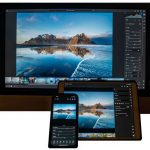Great images come from the vision of the photographer, from good visual design, sensitivity to light and good use of colour. Great images do not require expensive gear or the latest technology. The most important image making decisions are made before the click, since all we can do later in post-production is refine and polish what’s already there.
With that said, digital image capture and the editing possibilities that follow have opened up a whole new world of visual expression. In a sense we have been handed back the level of control possible in the hands of a skilled craftsman working in the chemical black & white darkroom. Digital post-production has however, taken those possibilities, extended them by an order of magnitude, applied it to colour in ways that were never possible in the chemical darkroom — and made all of this accessible to even beginner photographers.
There are lots of sources providing lessons on image editing in Photoshop and Lightroom. In most the emphasis is pretty much always on procedure and very prescriptive — mostly a walk through the author’s specific approach to editing. A consistent suggestion to, for example, “Move the shadow slider to the right open up the shadows” may fit that photographer’s style, but the bigger question in my mind is, “Why? Sometimes I like strong, dark shadows.”
This emphasis on process over vision, at least to me, is backwards. A photographer’s vision should always inform their approach to editing an image. You have to understand what it was about an image that caused you to pick up the camera in the first place. What visual elements in your image are most important in telling your story? Are other elements “stealing the viewer’s attention?” Emphasizing important visual elements, minimizing others, establishing an appropriate mood, and leading the viewer’s eye. You must have a at least some idea of how you will approach each of these questions before you begin to move any sliders.
After all, if you don’t know where you are going, how will know how to get there, let alone if you’ve arrived?
So, in this course is we flip the discussion, and focus on the image first rather then the process. At its most basic, all photography is about visual communication. With any photo, you are trying to show the viewer something about your subject. Our job as photographers is to evoke in our viewers the same emotional response we felt, in that place, at that moment when we clicked the shutter. Learning to edit images in this way begins with understanding why we choose to photograph certain subjects. It’s essential, but often difficult, to describe for ourselves what it is about an image that makes us want to capture it in the first place. Is it the light, a line, a pattern, or something else? Remember that sometimes the real subject isn’t a physical thing… for example, a mood can also be the subject. Thinking about this “before the click” is important because all you can do later in post is refine what is already there. When you understand what it was about an image that made you pick up the camera, you can plan your editing approach to help the viewer see the image as you did. Editing your images without a plan is like trying to write poetry by randomly banging on a keyboard.
So, while vision must always precede technique, technical mastery of the tools, the craft of photography can’t be ignored either. Without control of craft, you’re just flailing around in the dark. On the surface, this class is a deep dive into the Develop module of Adobe Lightroom Classic or Camera Raw. We cover every panel and each control in the Develop module in detail. More importantly, we describe how the controls, both global and local, interact with one another.
So, what is included with this course?
- 200+ pages of fully illustrated course material to use an ongoing reference.
- 4.5+ hours of video instruction.
- Downloadable Raw files for each lesson so you can follow along with the written lesson and video demonstrations.
- Detailed discussion and video walk through of many examples beginning with a description of the aesthetic goals for each image, and how these were realized in post.
- New added bonus: Group ZOOM session to discuss the course material and any photo related issues on your mind

Course Outline
Week 1:
- Style and Photographic Vision
- Understanding how we see; the concept of visual weight.
- A deeper look at Raw processing, White balance, Tone mapping and Presence controls, Selective colour controls
- Global vs. Local adjustments
- Masking tools in Lightroom 12
- Putting Raw processing to work
- Handling difficult contrast situations.
- Creative colour using curves or Color Grading (Lightroom 10+ only)
Week 2:
- Capture Sharpening and Noise Reduction
- Sharpening images with different levels of detail
- Sharpening high ISO images while controlling noise
- Sizing and sharpening for output
Weeks 3 and 4:
- Using Craft to Realize Vision
- From Click to Completion – examples.
Requirements for this course:
- This course deals with the desktop version of Adobe Lightroom Classic 12, although earlier versions are suitable as well.
- This course does not deal with the cloud-based version of Adobe Lightroom CC
- You should know how to import images into Lightroom and you should have at least a passing familiarity with the Develop module of Lightroom Classic or Adobe Camera Raw.
What do students say about Mark English?
Instructor: Mark English
 A photographer for more than thirty years, Mark is a former nationally accredited member of the Professional Photographers of Canada (PPOC). Known for his bold use of color and strong graphic elements in his image making, he now shoots primarily for personal projects. Most of his work is focused on editorial travel and landscape. His work has been published in a variety of media, and may be viewed at www.pacificlight.ca
A photographer for more than thirty years, Mark is a former nationally accredited member of the Professional Photographers of Canada (PPOC). Known for his bold use of color and strong graphic elements in his image making, he now shoots primarily for personal projects. Most of his work is focused on editorial travel and landscape. His work has been published in a variety of media, and may be viewed at www.pacificlight.ca
Testimonials:
“Thank you so very much for this course. It’s allowed me to take the blinders off and present my images for what I want them to be without being a slave to the “reality” of the camera. I would also add that in conjunction with your printing course, this has been the most useful course I’ve ever taken. Your notes are more than comprehensive and your comments and critiques are direct, clear, and always directed to the improvement of the art.” – Bill
“Thank you for this course. I am just loving everything about it!!! I know how much work it is to put courses together and you have done a fantastic job. Your materials are very good, and I love your critiques! Wonderful course!!!” – Eileen
“Thank you very much for a beautifully organized and presented course. Excellent written materials; videos; and your critiques were “spot-on”. I have exponentially increased my knowledge of Lightroom editing.” – Jay
“This course has been an invaluable learning experience on so many levels. Your instructive materials with detailed examples were excellent and worth reading and re-reading. I learned more about how to use LR effectively and don’t feel the need to go to PS to tweak my images as much now. Too, your critiques of my work and that of others were so very helpful. This class has really made a difference in how I will view and edit my photos in the future. Thank you!” – Anne
“Thank you very much for all the help. I have learnt so much about Lightroom in the last four weeks, and I will recommend your course to all my photo friends. You explained so many things that seemed impossible before, in a way that even Lightroom newcomers could understand them. Not all teachers can do that. I wish that all the BPSOP teachers had your qualities.” – Dianne
“Since this course, I pay more careful attention to what draws me to a subject, as well as the optimum exposure to achieve the best image and balance the visual weight. Get it right in camera and have FUN in post! I’m particularly enjoying painting with the local adjustment brush and enhancing natural colors in the HSL panel. Mark patiently taught me so much and went above and beyond with lengthy video critiques/responses to my submissions and confusions. If you want to go beyond the Basic Panel, I cannot recommend this course highly enough.” – Geraldine Macomber
To Learn more about how our courses work please visit: Course Info
















